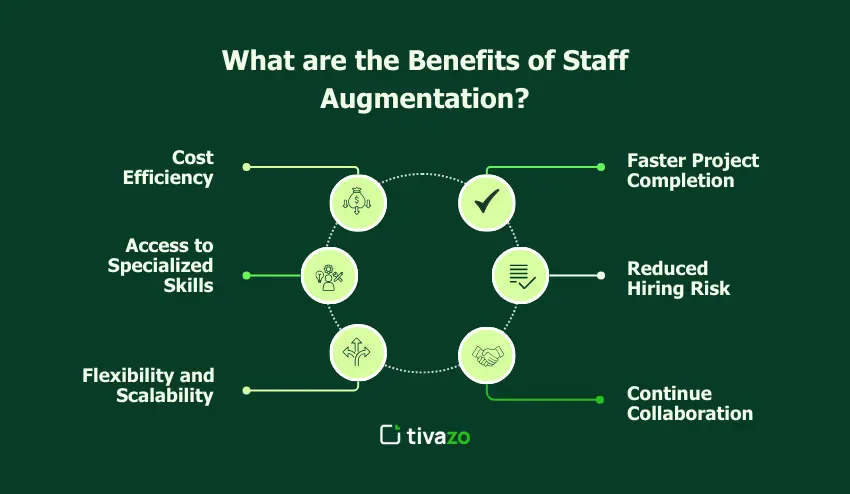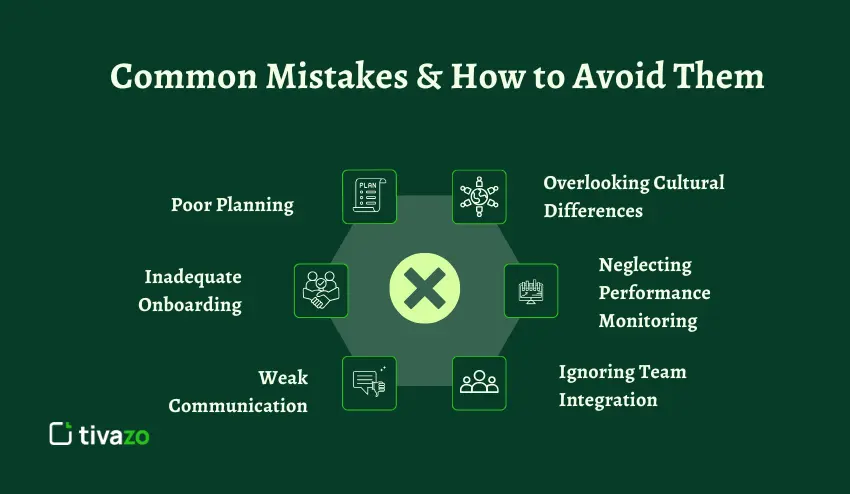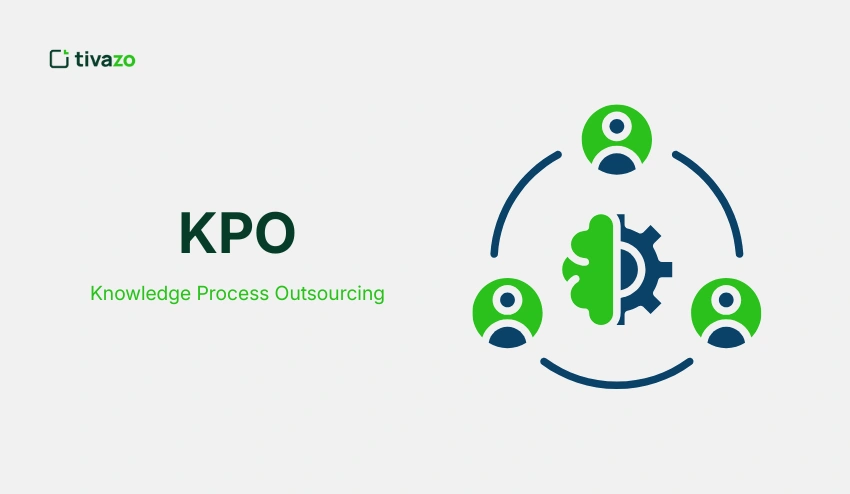By 2025, staff augmentation is emerging as a major business strategy of both large and small businesses. It enables businesses to hire skilled professionals on a short term basis without the commitment of hiring full time employees.
As a small business owner, project manager, or simply interested in the current workforce solutions, being acquainted with staff augmentation can enable you to make better choices in staffing your projects and team.
We will address all the details you require in this guide: what is staff augmentation, what kind of services can be provided, what are its advantages, how to succeed in this process, real life examples, tools, the most frequent mistakes, and the checklist that you can use in practice.
What is Staff Augmentation?

Staff augmentation is an adaptable outsourcing approach that enables companies to contract professional employees on a temporary basis to address skills shortages or workload surges. These professionals are not totally independent contractors as they work under your management and become part of your own team, unlike traditional hiring.
This is in contrast to full outsourcing whereby an external firm takes up a complete project. In staff augmentation, you have control over processes, deadlines and quality and access to specialized skills that might not be present within the organization.
Scenario: A software firm requires a mobile application developer to work on a 3-month project. They augment the staff by employing a skilled developer instead of full-time. The developer collaborates with the in-house team, finishes the project in an efficient manner and then the contract is terminated.
Why It Matters for General Users
Staff augmentation is not only a corporate strategy, but it applies to anyone participating in a project or team management, or business operations. Knowing it will enable you to make wise decisions regarding hiring, budgeting, and project planning.
Some key reasons it matters:
- Cost Efficiency: You will not be paying the overhead of full-time employees and can only pay the skills and time you require.
- Availability of Special Skills: Outsource professionals to do particular jobs without educating the current employees.
- Flexibility: Quickly scale your team up or down to suit the project requirements.
- Quickening Project completion: Added competent resources are used in the completion of projects in time.
- Less Hiring Risk: With short term contracts, there is less commitment in case a position fails.
Example: A marketing manager requires a UX designer to work on a six-week campaign. They do not employ the designer permanently but, through staff augmentation, bring him in to do the campaign and then release the resource.
Types of Staff Augmentation Services
Staff augmentation offers different models that may be used in different business needs. The choice of the type is a sure means to make sure that the projects are completed in an efficient manner, using the right skills and not necessitating the long-term employment commitments.
1. Traditional Staff Augmentation
This model involves hiring of professionals to fill some of the gaps in your internal staff. These experts usually work at the point and get employed until the issue or problem is resolved.
Scenario: An enterprise is in need of the services of a network engineer to upgrade its IT system within six months. They do not hire full time but rather hire a professional with the required knowledge.
Main Strength: Can get access to local talent fast and maintain control.
2. Offshore Staff Augmentation
The professionals are hired in a foreign country, typically across time zone. This will save labor, but it may require further coordination of communication and cultural alignment.
Situation: An IT company based in America contracts software developers in India to perform the development of the backend.
Key Benefit: Low cost and accessibility of talent pool in the globe.
3. Onshore Staff Augmentation
Recruiting of professionals is done in the country or region of origin of the organization. This facilitates easy and uniform communication with the local laws and culture of labour.
Scenario: A healthcare company in Germany has hired a local regulatory compliance consultant to undertake a short term project.
Key Strength: Easy collaboration and rapid integration due to language and time zone similarity.
4. Remote Staff Augmentation
Professionals work at home and join your existing staff virtually. It is a dynamic form of model and allows talent to be accessed anywhere.
Scenario: A Canadian start-up hires a UX designer located in Spain to a mobile app.
Major Strength: Bigger access to specialized skills.
5. Agile Staff Augmentation
A team of multi-disciplinary type is constituted to handle a project to the end. This is common in technology or data projects which require various expertise levels.
Example: An analytics project may consist of a programmer, an AI engineer, a data analyst, and a BI specialist to create and implement a complete solution.
Value Addition: The entire project implementation with integrated team knowledge.
6. Project-Based Staff Augmentation
Experts are hired to undertake work within a certain project. This model is appropriate in complex projects that are characterized by special resources.
Scenario: A case in point is a construction company that hires a structural engineer to be involved in the process of building a structure.
Primary Strength: Specialization will ensure that the project is accomplished within the schedule and quality requirements.
7. Skill-Based Staff Augmentation
The team gaps are addressed by contracting temporary specialists who have special skills.
situation: A FinTech start-up has a cybersecurity specialist who has been hired to ensure that its payment system is compliant with the regulatory requirements.
Main Strength: Availability of high demand skills not in the long run.
8. Time-Based Staff Augmentation
Professionals are hired within a given period that could span months or even years.
Situation: A company is outsourcing the services of a business analyst to complete a one-year project of migrating to a new system.
Professional Benefit: It provides long-term work projects without necessarily having to add permanent employees.
9. Hybrid Staff Augmentation
Combines different approaches to accommodate special projects. One such example is that a team may have on-site and remote members.
Example: A company hires a site engineer to perform significant work and offsite developers to assist with the work by supplying additional code.
Significant Strength: Tailored and affordable solution that is flexible and collaborative.
10. On-Demand Staff Augmentation
Extremely selective sources, technical expertise on a global scale, on-demand to satisfy the urgent project needs.
Situation: An advertising agency hires a freelance graphic designer on a freelancer site to provide a campaign on a tight deadline.
Significant Benefit: The fast action and instant access to a professional whose specialized services are not recruited in time.
What are the Benefits of Staff Augmentation?
Staff augmentation must be strategized and properly handled in order to capitalize on it. The appropriate strategies will ensure successful integration and success of the project.

1. Cost Efficiency
Before recruiting, the skills, experience and the required number of professionals should be specified. Understand what the gaps in your current team are.
Situation: In a software company, a front-end developer and a UX designer are needed to complete a three-month project. Recruiting targeted needs will help in finding the right talent.
2. Access to Specialized Skills
Choose a staff augmentation partner with a good track record and with access to the required skill set. Check references, past projects and checking.
Scenario: An organization that is seeking cybersecurity professionals conducts a background check of providers that have successfully implemented similar projects.
3. Flexibility and Scalability
Ensure that new professionals are oriented accordingly and they have the tools, processes, and culture of your company. Communication lines are significant.
Examples: Remote developers are given access to project management tools, style guides, and regular team meetings.
4. Faster Project Completion
Decision on what will be left to the in-house teams and what will the augmented staff deal with. This eliminates redundancy and fraud.
5. Reduced Hiring Risk
Regular check-in on engagement-related performance and progress ensures the project is on track and is meeting the level of expected quality.
6. Continue Collaboration.
Manage communications and collaboration both internally and externally with professionals who have augmented experience. Shared goals and feedback yield better efficiencies.
Common Mistakes & How to Avoid Them
Staff augmentation is flexible and is specialized but the mistakes in planning or management can reduce its effectiveness. Being aware of such pitfalls and how to avoid them will ensure the process of integration and the better outcomes.

1. Poor Planning
The absence of compatibility may be caused by the recruiting of experts without specifying either the project needs or the lack of skills. This leads to wastages and delays and frustrations to the two teams.
Scenario: A company recruits software developers without specifying the kind of skills they need i.e. front end or back end and this is what results in duplication of work and missed deadlines.
Solution: Before expanding your staff, conduct a detailed analysis of skills and resources. Fix particular roles, responsibilities and timeframes.
2. Inadequate Onboarding
The temporary staff might struggle to cope unless they are introduced to the company processes, tools or workflows. Absence of a proper onboarding strategy will result in low productivity.
Scenario: In a case when the team has a remote UX designer, he does not have access to project management software or branding specifications, which causes confusion and errors.
Resolution: Develop a systematic checklist onboarding to be used in order to cover tool access, project briefings and team introductions.
3. Weak Communication
The lack of consistency and ambiguity in communication can make offshore or remote employees feel alienated. There can be misunderstanding and errors because of the absence of updates.
Situation: A time zone developer cannot receive the much-needed feedback since the meetings are arranged without considering his/her time.
Solution: To have good communication, check-ins, messaging services, and shared documents should be done on a regular basis. Consider time zone when holding meetings.
4. Overlooking Cultural Differences
Cultural and territorial diversities can condition collaboration, working expectations, and communication patterns. Lack of consideration of these can slow down projects.
Example: An offshore team may be allowed to have different holidays or workweeks and this causes delays in deliverables.
Solution: Educate about cultural awareness, develop expectations and schedule plans that permit differences.
5. Neglecting Performance Monitoring
There is a risk of missed deadlines and quality issues due to the assumption that augmented staff is bound to deliver results. Unmonitored projects can be misguided.
Example: When a project manager makes an assumption that a contractor should know the priority jobs, this means that work will not be completed and the fix will be completed at the last moment.
Solution: Keep track of the progress using project management and time tracking software, provide frequent feedback and reallocate tasks.
6. Ignoring Team Integration
The augmented staff that does not form part of the teams of the in-house personnel may feel isolated or detached, which reduces efficiency and engagement.
An example: Non-permanent employees are not part of the stand-ups of the daily meetings, and this creates a mismatch in the project goals.
Solution: The employees are to be engaged in meetings, collaborative sessions, and decision-making to make sure that there is alignment and teamwork.
Conclusion
Staff augmentation is a scalable and affordable approach that assists companies of all sizes in addressing skill gaps, staffing teams in a short time, and gaining specialized expertise. Organizations can easily integrate temporary professionals with their projects by learning more about the various types, the advantages, and the best practices to use.
Efficiently applied, staff augmentation can speed up project schedules, minimize risks associated with hiring, and can make sure that teams have the appropriate skills at the appropriate time without permanent hiring that takes years to be fully realized.




